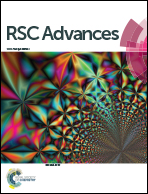Promotional effects of rare earth elements (Sc, Y, Ce, and Pr) on NiMgAl catalysts for dry reforming of methane†
Abstract
In this work, the promotional effects of rare earth elements (Sc, Y, Ce, and Pr) on NiMgAl catalysts derived from layered double hydroxides were investigated for dry reforming of methane (DRM). It was found that the modified catalysts showed improved catalytic stability and coke resistance, which may result from the following favorable properties: enhanced surface basicity, abundant oxygen vacancies, superior redox properties and highly dispersed Ni particles. Notably, the Ce or Pr modified catalysts showed higher performance than the others. It may be that the addition of Ce or Pr can increase the amount of strong basic sites. Furthermore, the coexistence of redox pairs, like Ce3+/Ce4+ or Pr3+/Pr4+, can contribute to the enhancement of redox properties and formation of oxygen vacancies simultaneously. The high oxygen vacancies and excellent redox properties can significantly help to improve the catalytic stability. In situ diffuse reflectance infrared transform spectroscopy analysis illustrated the details of carbonate species forming during the adsorption of CO2, and the transient studies investigated the dynamic changes of the adsorbed intermediate species during catalysis processes for getting deep insight into the catalytic mechanism. Adding various rare earth elements can lead to different chemical environments and electronic effects of the surface, and it is crucial to investigate how these additives affect the behavior of the catalysts surface and interface, thus, identifying the catalytic mechanism via the elucidation of the promotional effects of these properties on the catalytic performance.



 Please wait while we load your content...
Please wait while we load your content...